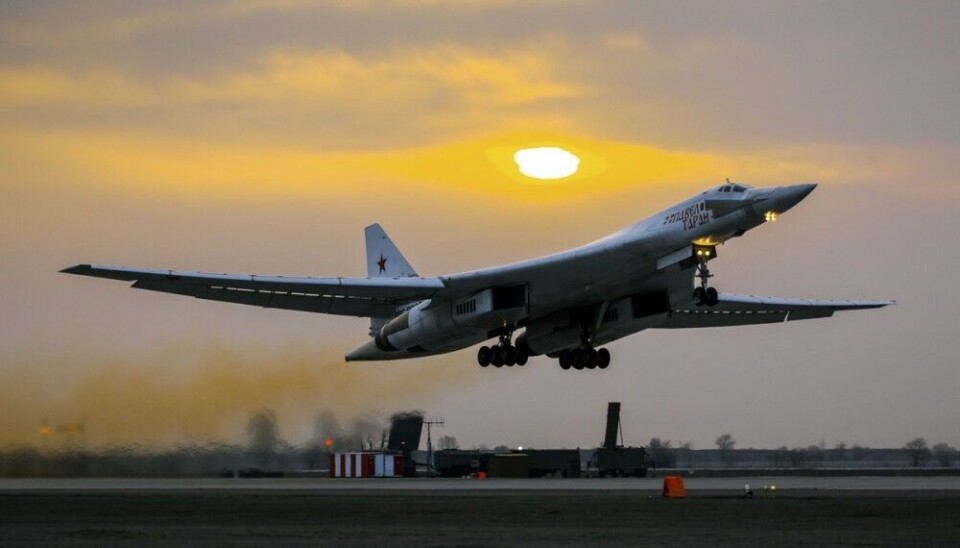
Satellite image shows 16 strategic bombers deployed to Kola Peninsula
Packed to capacity: All aprons along the runway at Olenya Air Base are now occupied by Russia’s largest and heaviest combat aircraft, a satellite image from this week reveal.
Located only 200 km from NATO-members Finland and Norway, Olenya Air Base is closely watched by military analysts. The 3,500 m runway normally serves a small fleet of elderly Tu-22M supersonic bombers and a few An-12 military transport planes.
Last autumn, however, the role of the air base as a forward deployment field for long-range aviation was activated.
The first four Tu-160 strategic bombers came in August and by October there were more than ten Tu-95 and Tu-160 aircraft deployed, as previously reported by the Barents Observer.
Sending such heavy bombers north “is certainly signaling,” said Professor Katarzyna Zysk with the Norwegian Institute for Defense Studies.
The strategic bombers now deployed inside the Arctic Circle were previously based at Engels near the city of Saratov. Located only 600 km from the border with Ukraine, the air base proved vulnerable when two of the TU-95 planes were damaged after what was believed to be a drone attack last December.
On May 13, two Russian fighter jets crashed in the Bryansk region, some 40 km from the border with Ukraine. Two Mi-8 helicopter smashed to the ground the same day. It is still unknown if the aircraft were shut down.
This week’s new satellite photo from Olenya clearly indicates that Russia’s strategic aviation forces flew north for more than a short-term evacuation away from the Ukrainian neighborhood.
All aprons along the runway are occupied. In the southern end, two Tu-160 are parked, while 14 Tu-95 stand side-by-side at all the other aprons big enough for larger planes.
Tu-22M planes are moved to the parking areas in the northwestern part of the air base.
One Il-78 aerial refueling tanker is parked sideways with its wing partly outside the apron not to block the taxiway for the strategic bombers. The planes can be airborne on short notice. That gives Norway and Finland a shorter warning to scramble fighter jets to identify flights close to the countries’ airspace. In late April, NATO scrambled a pair of F-35s to meet a formation of seven Russian planes, including two Tu-160 bombers, flying international air space north of Norway’s Finnmark region.
OLENYA AIR BASE0.5M from 7 May 2023 of the flight line. For anyone that follows @olga_pp98, you would know that Tu-95 aircraft from Olenya have been involved in recent missile launches into Ukraine. pic.twitter.com/HKLqZO5hPj
Both the Tu-160 and Tu-95 are capable of carrying nuclear warheads. Russia’s central storage for nuclear warheads, Bolshoye Ramozero, is 10 km from Olenya Air Base.
Why it matters: Security Council Deputy Chairman and former president, Dmitry Medvedev, is assigned by the Kremlin to dangle nuclear threats. His rhetoric has worsened from month to month as Russia is losing ground in Ukraine. “The defeat of a nuclear power in a conventional war may trigger a nuclear war,” Medvedev recently wrote on his Telegram channel.
Recent reports also indicate that the strategic bombers flying out of Olenya Air Base participate in cruise missile attacks on Ukraine.
A HF radio observer, tracking the activities of Russia’s strategic aviation forces, has reported nearly daily flights out of Olenya Air Base over the last week. That includes both training missions inside Murmansk region air space and combat missions with firings on targets in Ukraine.
The Kola Peninsula plays a vital role in Russia’s unprovoked bloody war on its neighboring country. The Barents Observer has previously reported about thousands of soldiers from the border regions to Norway and Finland killed and wounded. Warships from Severomorsk with the Northern Fleet have taken part since the start of the war 15 months ago.















